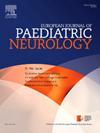Can inter-stride variability capture signs of mixed tone in individuals with cerebral palsy? An exploratory study
IF 2.3
3区 医学
Q3 CLINICAL NEUROLOGY
引用次数: 0
Abstract
Introduction
The identification of dystonia in addition to spasticity (mixed-tone) for individuals with cerebral-palsy (CP) is important, as it can alter clinical management. This study aims to examine if the inter-stride variability of conventionally used gait features can be used for recognizing mixed-tone during gait in individuals with CP.
Methods
Retrospective treadmill-based 3D gait-analysis data for 20 individuals (mean ± SD age 10.4 ± 3.3 years) with mixed-tone CP were extracted (mixed-tone-group). A control group of individuals diagnosed with spastic-CP and no dystonia during gait were individually matched (spastic-group). Gait-kinematics were evaluated using Spatiotemporal characteristics and the Gait-Profile-Score (GPS). Selective-motor-control was assessed by the dynamic-motor-control-index (walk-DMC). Inter-stride variability was calculated per-individual using the coefficient-of-variation (CV; (SD/mean)∗100).
Results
The mixed-tone-group presented with significantly smaller step-length and higher CV only in spatiotemporal parameters (p < 0.050). After controlling for walking-speed, only the CV for cadence remained significant (p < 0.001); a cut-off of 11.5 % CV in cadence could identify individuals with mixed-tone CP with 65 % sensitivity and 85 % specificity.
Interpretation
Larger inter-stride variability was identified for spatiotemporal characteristics in individuals with mixed-tone CP, compared to individuals with spastic CP. Capturing the highly variable movements may be a biomarker of dystonia during gait. Further prospective studies with larger sample size are needed.
跨步幅变异性是否能捕捉脑瘫患者混合音调的迹象?探索性研究
脑瘫(CP)患者除痉挛(混合性)外,肌张力障碍的识别很重要,因为它可以改变临床管理。本研究旨在探讨常规步态特征的跨步变异性是否可以用于识别CP患者步态中的混合音调。方法提取20例混合音调CP患者(平均±SD年龄10.4±3.3岁)的回顾性跑步机三维步态分析数据(混合音调组)。诊断为痉挛性脑瘫且步态中无肌张力障碍的对照组被单独匹配(痉挛组)。利用时空特征和步态轮廓评分(GPS)对步态运动学进行评价。采用动态电机控制指数(walk-DMC)评价电机控制的选择性。跨步变异性计算采用变异系数(CV;(SD /意味着)∗100)。结果混合音调组仅在时空参数上表现出较低的步长和较高的CV (p <;0.050)。在控制步行速度后,只有节奏的CV仍然显著(p <;0.001);以11.5%的CV为截断值,以65%的敏感性和85%的特异性识别混合性CP患者。解释:与痉挛性脑瘫患者相比,混合性脑瘫患者在时空特征上的跨步变异性更大。捕捉高度可变的运动可能是步态肌张力障碍的生物标志物。需要进一步的更大样本量的前瞻性研究。
本文章由计算机程序翻译,如有差异,请以英文原文为准。
求助全文
约1分钟内获得全文
求助全文
来源期刊
CiteScore
6.30
自引率
3.20%
发文量
115
审稿时长
81 days
期刊介绍:
The European Journal of Paediatric Neurology is the Official Journal of the European Paediatric Neurology Society, successor to the long-established European Federation of Child Neurology Societies.
Under the guidance of a prestigious International editorial board, this multi-disciplinary journal publishes exciting clinical and experimental research in this rapidly expanding field. High quality papers written by leading experts encompass all the major diseases including epilepsy, movement disorders, neuromuscular disorders, neurodegenerative disorders and intellectual disability.
Other exciting highlights include articles on brain imaging and neonatal neurology, and the publication of regularly updated tables relating to the main groups of disorders.

 求助内容:
求助内容: 应助结果提醒方式:
应助结果提醒方式:


